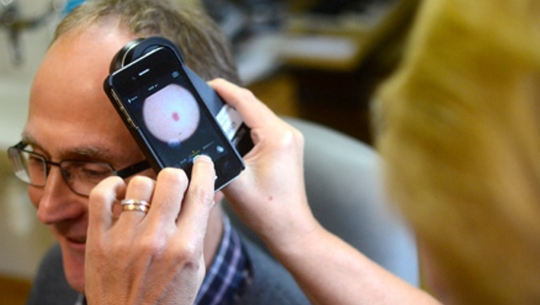Early diagnosis and action is of great importance for the survival of patients with malignant melanoma. Until 2012, a referral-free mole assessment was offered at the University Hospital of Umeå in Region Västerbotten that was supposed to support the entire population in Västerbotten. However, the patients who sought help there weren’t always those with the greatest needs.
As of 2014, mole assessment is offered at all healthcare centres in Västerbotten. The patient is photographed with a dermatoscope attached to a mobile phone. The images are stored in the patient’s medical record and a referral with a reference to the images is sent to Dermatology Clinic. Based on the images, a dermatologist judges whether or not the condition needs surgery, treatment or if it is best left unattended.
Healthcare becomes more equitable for all residents in the county and the time to diagnosis and potential treatment is shorter. The number of unnecessesary surgeries has declined and the lead times has shortened considerably. Fewer physical visits has also led to less travel for the the patients with positive effects for the environment as well as economical gains.
Inhabitants in the entire county of Västerbotten where there is a suspicion of skin cancer. Doctors, nurses and medical secretaries in primary care as well as dermatologists and medical secretaries in the hospital
 Distance treatment
Counseling via online tools with associated treatment or own treatment.
Distance treatment
Counseling via online tools with associated treatment or own treatment.
 Distance monitoring
Social care remotely with sensors, cameras, reminders and data collection.
Distance monitoring
Social care remotely with sensors, cameras, reminders and data collection.
 Distance meetings
Close care concepts that move the point of healthcare closer or into the citizens' own homes.
Distance meetings
Close care concepts that move the point of healthcare closer or into the citizens' own homes.
 New distance-spanning solutions
New innovative solutions, new national infrastructure for digital services and service models where citizens can take greater responsibility.
New distance-spanning solutions
New innovative solutions, new national infrastructure for digital services and service models where citizens can take greater responsibility.
 Show all solutions
Show solutions from all four categories
Show all solutions
Show solutions from all four categories
